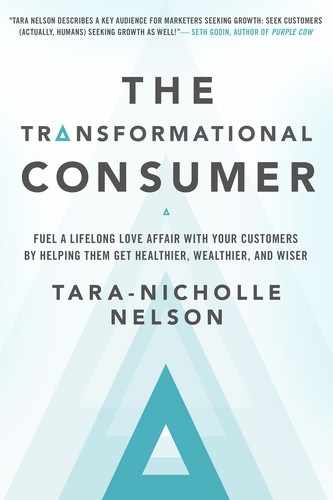CONCLUSION
Transcendence: The Natural State of Things
Now you are at the point in your Leader-Hero’s Journey where it’s time to embark on a voyage to that supernatural otherworld, beyond the world of business as usual and into the messy, human-centered realm of helping people change their lives.
Some things can’t come with you on this path: cynicism, flippancy, learned helplessness, and fear, among them. These must be released, before you set out.
Then, you’ll need to take stock and gear up for this journey.
You’ve got your guidebook. My team and I are available to you as a resource, even if only to point you in the right direction of others who can help. You might also need to bring on new sources of energy, tools, skills, practices, and helpers. Chances are good you’re already getting a sense for what skills you’ll need to bring on or cultivate in yourself or your team. At www.bkconnection.com/transformationalconsumer-sa, you’ll find the Transformational Consumer Self-Assessment: What Do You Need to Rethink First? It’ll help you get clearer about what your specific first step on the journey should be and help you sequence a custom roadmap for carrying out the rethinks in your own business.
If you want to go even deeper, at TransformationalConsumer.com you’ll find a series of free resources to help you gear up, craft, and carry out your individual and organizational action plans for transcending the transactional. I highly recommend taking advantage of the following free resources at TransformationalConsumer.com, at the very least:
![]() The “Are you really a transformational leader?” individual self-assessment
The “Are you really a transformational leader?” individual self-assessment
![]() The Customer Loyalty and Engagement Audit
The Customer Loyalty and Engagement Audit
![]() The Customer Journey Mapping checklist.
The Customer Journey Mapping checklist.
This journey may be daunting, but it’s also rewarding, professionally and personally. Guard against overwhelm by keeping one thing in mind. Transcending the transactional might seem like a fantastical, supernatural realm that you can only get to by winning a number of battles, internally and in the marketplace. This is true.
But carrying on a love affair with your customers is actually the most natural thing of all. To engage in relationships between customer and company on the basis of a mutually desired, mutually beneficial exchange of value for value is a return to the natural, original flow of commerce—this is the way things were before distrust and disengagement got in the way. When humans first began conducting commerce, it was not purely transactional: vendors played various societal roles, beyond selling stuff, and people had relationships with those who helped them stock their homes and make their lives function better than before. This is not new. This is a return to what’s natural.
Workplaces in which people find opportunities for mastery, purpose, and engagement? This is not the norm now, but it is not supernatural. Rather, the current disengagement epidemic is super unnatural. The right and natural role of livelihood in our lives is to be a source of growth and expansion and joy and fulfillment. Creating a workplace conducive to engagement and transformation, inside and out, harks back to a time when people were so proud of our work that we made it part of our identity, taking the name Cooper, Smith, or Baker.
So, take heart, hero-leader. And then take the first step. That might be bringing this book to your next executive team meeting. It might be commissioning some research to get a better understanding of your own Transformational Consumer audience. It might be sitting down to do some informal online listening of your Transformational Consumer audience, right this moment. It could definitely be to write down, right now, the answer to this question: What is the human-scale, high-level problem our company exists to solve for our customers?
As is true for every personal disruption campaign and every HWW goal of the Transformational Consumer, the precise first step you take on your Leader-Hero’s Journey is less important than that you take it. On that note, I’ll close with a slightly different version of the 1951 W. H. Murray quote we looked at earlier, his notes in recounting a Scottish expedition he’d led into the Himalayas:
But when I said that nothing had been done I erred in one important matter. We had definitely committed ourselves and were halfway out of our ruts. We had put down our passage money—booked a sailing to Bombay. This may sound too simple, but is great in consequence. Until one is committed, there is hesitancy, the chance to draw back, always ineffectiveness. Concerning all acts of initiative (and creation), there is one elementary truth, the ignorance of which kills countless ideas and splendid plans: that the moment one definitely commits oneself, then Providence moves too. 1
